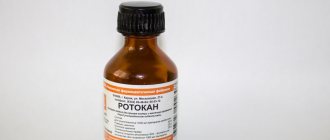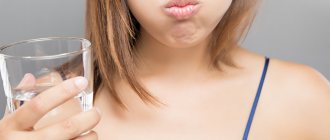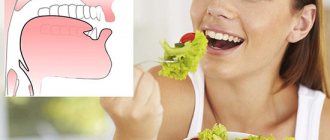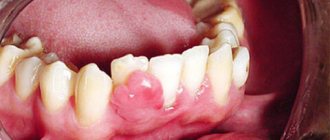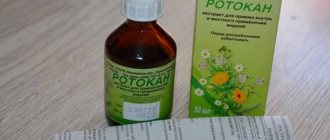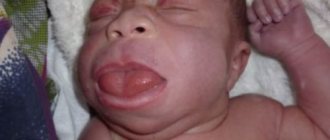September 9, 2022 Which remedy should I choose for a sore throat or diseases of the oral mucosa? Almost all diseases of the oral cavity are accompanied by inflammation. Inflammation is a pathological process that develops in response to a damaging factor.
There are three stages of inflammation:
- 1. Damage to cells and tissues. At this stage, symptoms of the disease appear, including pain.
- 2. Increased vascular permeability , release of inflammatory mediators. Swelling appears and symptoms persist.
- 3. Restoration of damaged tissues. At this stage, recovery occurs.
Therefore, a remedy for the treatment of inflammatory diseases of the oral cavity must eliminate pain, inflammation and pathogens.
Various drugs are used to treat inflammatory diseases, including antiseptics and NSAIDs.
Effect on the body
The effect of use can be explained by the presence of 3 main components in the medicine. Properties of plant components:
- Calendula officinalis flowers - relieves inflammation, reduces the ability of capillaries to pass liquid through the walls, has an antimicrobial effect, stimulates the liver, improves the condition of bile, reduces the concentration of cholesterol in the blood, improves the functioning of the digestive glands;
- chamomile flowers - relieves the inflammatory reaction, has antispasmodic and antimicrobial properties, stops fermentation in the intestinal cavity, improves the secretory activity of the digestive glands;
- yarrow herb - relieves inflammation, kills bacteria, relieves spasms of the digestive organs, stimulates the formation of bile and gastric juice, eliminates allergy symptoms, helps quickly stop bleeding in small wounds and injuries due to the formation of fibrin.
Together, all components complement and enhance each other's effects.
When should you use mouthwash?
With halitosis. If bad breath occurs frequently, a mouthwash will help remove it. It reduces the number of bacteria, slows down their reproduction, and cleans even those areas that cannot be reached with a toothbrush (subgingival, interdental areas, surface of the tongue, gums, cheeks). When rinsing, residues and food particles are washed away, which can cause an unpleasant odor.
If caries appears frequently. It is formed when plaque accumulates on the enamel, when the acidity in the mouth becomes too high (including due to the active growth of bacteria). Antibacterial solutions help reduce acidity, and additional cleansing reduces plaque formation. The mouthwash may contain fluorides or other mineral components that strengthen the enamel, restore its structure, and protect against caries.
With the rapid appearance of tartar. It is formed when soft plaque hardens. It can only be removed with professional cleaning. To prevent tartar from appearing again, effective hygiene is important. Using rinses, you can slow down the formation of deposits: they wash the enamel surface, remove food particles, slow down the growth of bacteria, and help keep teeth clean throughout the day.
If the enamel is highly sensitive. In this case, you need to use solutions with a mineralizing effect. They must contain fluorides. When rinsed, they penetrate the enamel structure, restore it, strengthen it and reduce sensitivity. It’s good if the solution is also antibacterial: it will help reduce acidity in the mouth, eliminating pain.
For bleeding or inflammation of the gums. The use of solutions with anti-inflammatory and antibacterial effects is part of the prevention and treatment of gum disease. They help relieve inflammation, accelerate the healing of the mucous membrane, and slow down the formation of tartar under the gingival margin.
Dosage forms of the drug
For ease of use, several forms of the medicine are available. List of forms:
- solution for local and oral use (25, 50, 55, 55, 90, 110 ml);
- solution for local use only (ready-made) Vialine (200 ml);
- Vialine spray (45 ml).
Spray and solution for local use can be used for damage to the oral cavity and pharynx. Oral administration of the medicine is recommended in solution for digestive pathologies.
The drug is produced in the form of a concentrated herbal solution, which has a specific odor. The liquid is poured into a dark glass bottle. The container is packed in a cardboard box.
Rotokan - how to use it?
According to the instructions for use, Rotokan can be used topically, orally and rectally. The method of application depends on the type of pathology.
The medication is used locally in the form of an aqueous solution.
Many patients ask how to breed Rotokan. To prepare a working solution, take 250 ml of boiled water and 5 ml of concentrate. If the patient tolerates the standard working solution well, if necessary, you can increase the concentration by adding up to 15 ml of Rotocan. The dosage can be increased only according to the doctor’s recommendations.
Rules for using the working solution (topically):
- In dentistry, after removing deposits and cleaning gum pockets, turundas soaked in a working solution are introduced into the gum pockets; hold for 20 minutes; Therapy is carried out 1 time per day, every day or every other day. Number of procedures: 4-6.
- Pathologies of the oral mucosa - apply for a quarter of an hour or rinse for 1-2 minutes. Events are held twice or thrice a day for 2-5 days.
Rotokan is indicated for adults for pathologies of the digestive tract. The working solution is taken 80-125 ml half an hour before a meal or an hour after a meal. The frequency of administration is 3-4 times a day. Course therapy is 14-21 days.
In gastroenterology, the medication can be used rectally. Microclysters are carried out with 50-100 ml of working solution. Microenema is indicated 1-2 times a day. The course of therapy is 3-6 days. A cleansing enema is recommended before the procedure.
Rotocan, extract for oral and topical use (liquid), 50 ml, 1 pc.
Yaroslavl pharmaceutical factory, Russia
Price from 49₽
Rotocan, extract for oral and topical use (liquid), 25 ml, 1 pc.
VIFITECH, Russia
Price from 25₽
Rotocan, extract for oral and topical use (liquid), 100 ml, 1 pc.
VIFITECH, Russia
Not available
There are contraindications. Specialist consultation is required.
Chlorhexidine bigluconate
Belongs to the group of halogens. Typically used in concentrations of 0.5–4.0%. At lower concentrations, the bactericidal activity of chlorhexidine decreases, therefore, as an antiseptic in this case, it is used only in an alcohol solution. Chlorhexidine has bacteriostatic, fungicidal, antiviral properties. However, 1% chlorhexidine against fungi and mycobacteria tuberculosis has a weaker effect compared to povidone-iodine. The drug can be used for the initial treatment of injured skin areas, as well as to accelerate the healing of purulent wounds and for the treatment of damaged mucous membranes. In most cases it is well tolerated. There are no age restrictions for use - a good antiseptic option for children. It is not recommended to use together with iodine preparations (often skin irritation).
Rotokan - how to gargle?
Gargling should be done with Rotokan working solution (according to the instructions, the drug should be diluted in water). The liquid temperature should be 30-40 °C. This will help prevent hypothermia of the mucous membrane. The solution should not be hot, as this will cause burns.
To gargle properly, you should take a little working solution into your mouth, and then slowly tilt your head back. While rinsing, pronounce the sound “A” or “Y”. After the procedure, you should not eat or drink for half an hour so as not to wash off the medicine.
Rotocan is prescribed by dentists for treating gums. To do this, a small amount of solution is taken into the mouth. Use your tongue to move the liquid around the mouth for a few seconds and then spit it out. Next, take a fresh portion of the medicine and repeat the procedure. The procedure is carried out until the working solution in the glass runs out.
Classification of antiseptics
Halides (halogens and halogen-containing compounds) Chlorine or iodine compounds (antiformin, iodoform, iodinol, Lugol's solution, chloramine B, chlorhexidine).
The bactericidal effect is based on the fact that upon contact with organic substrates, these products release active halogens - chlorine and iodine, which destroy the proteins of microorganisms. Due to their high bactericidal activity, they are widely used both in medical institutions and at home. Oxidizing agents (hydrogen peroxide, potassium permanganate, hydroperite). In contact with tissues, they release active oxygen, which creates unfavorable conditions for the development of anaerobic and putrefactive microbes. They are used to a limited extent due to their moderate bactericidal activity and short shelf life. Acids (salicylic, boric). A shift in pH to the acidic side leads to denaturation of the protoplasmic protein of the bacterial cell. Salicylic acid has a weak antiseptic effect, and boric acid has a large number of side effects associated with toxicity. Currently, antiseptics for treating skin are practically not used as antiseptics. Alkalies (ammonia, sodium tetraborate). Currently, drugs are practically not used as antiseptics due to their low antiseptic activity. Aldehydes (formalin, lysoform). Penetrating inside the microbial cell, they come into contact with the amino groups of proteins, which leads to cell death. The same effect explains the strong irritant effect on human mucous membranes and skin. Currently, they are used more for disinfecting surfaces in medical institutions. Alcohols (ethyl). They dehydrate tissues and irreversibly coagulate the proteins of microorganisms. They are used quite widely and have a pronounced antiseptic effect. In 2006, the WHO declared alcohol-based hand sanitizers to be the gold standard for hand sanitizers. Cationic antiseptics (benzyldimethyl-myristoylamino-propylammonium). The active substance acts on the membranes of microorganisms, leading to their death. It has a very wide spectrum of antimicrobial action, stimulates the immune system, and accelerates the healing process of wounds. Widely used in surgery, obstetrics, gynecology, traumatology, burn therapy, otorhinolaryngology and other fields of medicine. Salts of heavy metals (preparations of mercury, silver, copper, zinc, lead). The antimicrobial effect is associated with blocking the sulfhydryl groups of microbial enzymes. Use is limited due to toxicity. Dyes (methylene blue, brilliant green, fucorcin). They are active against gram-positive bacteria and cocci. Methylene blue has a very weak antiseptic effect and is practically not used. Herbal antibacterial drugs (urzaline, calendula tincture, imanin and others). Weak antiseptic properties. Rarely used. All these substances have different degrees of activity, antimicrobial spectrum and toxicity. To understand how to choose the right antiseptic, you need to be guided by all these characteristics in accordance with the intended purpose: primary wound treatment, treatment of festering wounds, or treatment of damaged mucous membranes or intact skin/mucous membranes. When choosing which antiseptic to treat a particular wound, you must also follow the instructions in order to avoid side effects, as well as determine the dosage required in a particular case. Let's take a closer look at the most popular antiseptics.
Rotocan - is it possible to use it in gynecology?
Rotokan is not prescribed topically or orally for gynecological diseases. You should not use the medicine for douching, as it is alcohol-based. Getting alcohol into the genital tract can lead to irritation of the vaginal mucosa. A local allergic reaction is also possible to a complex of medicinal herbs. Chlorhexidine or miramistin are suitable for douching. If gynecological diseases occur, you must visit a gynecologist to clarify the diagnosis and complete examination. The doctor will conduct an examination and prescribe the correct therapy.
Octenidine (octenidine dihydrochloride)
A cationic surfactant with antimicrobial activity against gram-positive and gram-negative bacteria, viruses, as well as against yeast-like fungi and dermatophytes (fungi that feed on keratin and cause dermatomycosis). Similar in action to quaternary ammonium compounds (QAC). The damaged surface is completely processed. Can be used on mucous membranes. The antiseptic has no age restrictions and is used for children. Currently, it is the drug of choice in Europe as an antiseptic due to its wide spectrum of action and maximum speed of achieving effect.
Table 1. Comparative characteristics of the main antiseptic agents
| Antiseptic | For leather processing | For treating wounds | For mucous membranes | Applicability for children |
| Ethanol | + | _ | _ | — |
| Hydrogen peroxide | + | + | + | + |
| Iodine | + | _ | — / + | — / + |
| Chlorhexidine | + | + | + | + |
| Potassium permanganate | + | _ | _ | + |
| Diamond green | + | _ | _ | + |
| Fukortsin | + | _ | _ | _ |
| Benzyldimethylmyristoylaminopropylammonium | + | + | + | + |
| Octenidine | + | + | + | + |
special instructions
The medicine is made on an alcohol basis (ethanol at least 33%). The maximum daily dose of the working solution contains ethanol in the following quantities:
- 250 ml of water and 5 ml of Rotokan - 32 g;
- 250 ml of water and 15 ml of Rotokan - 95 g.
Alcohol dosages should be taken into account when using the drug, especially if it is administered orally or rectally. Also, the medication, due to its ethanol content, reduces the reaction rate, so it should not be used by patients who work with machinery (drivers, mechanics).
Fukortsin
Coloring antiseptic. A combination of fuchsin, boric acid, phenol, acetone, resorcinol and ethanol. Indications for the use of fucorcin are fungal and pustular skin diseases, abrasions, cracks, etc. Apply to the edges of wounds. Has less drying effect than brilliant green and iodine. It is used much less frequently in wound treatment. It is undesirable to use in children due to the boric acid and phenol contained in it, which have a large number of side effects. When applied to the skin, boric acid easily penetrates the blood (especially in children) and enters the internal organs and tissues, accumulating there. Therefore, long-term use can cause intoxication. This property forced us to sharply limit the use of boric acid, especially in childhood. Phenol also has the ability to easily penetrate the skin and lead to intoxication of internal organs.
Analogs
Close non-structural substitutes that are used both in dentistry and gastroenterology are Romazulan. It contains chamomile extract and guaiazulene. Sold as a solution.
Substitutes for dental and other pathologies of the oral cavity:
- Periodontocide - contains clary sage oil, mint oil solution, clove oil, allantoin, thymol, phenyl salicylate; used for bleeding and damaged gums, wearing dentures.
- Stomatidine - contains hexetidine, indicated for tonsillitis, pharyngitis, stomatitis, bleeding gums, tongue diseases, oral candidiasis and other conditions.
The choice of drug is made only by the doctor. You should not select substitutes yourself.
Rotocan is actively used in dentistry and gastroenterology. Due to the combined composition, the effectiveness of treatment increases. The drug rarely provokes adverse reactions. Of all the undesirable effects, only allergies are listed in the instructions. The cost of the medicine is not high. In pharmacies, the medicine is dispensed without a doctor's prescription.
Content:
- The importance of choosing the right medicine
- Conditions that must be met by high-quality compositions 2.1. Iodine preparations 2.2. Chlorine 2.3. Preparations based on hexethidine
- For what purpose is it used?
- Indications for use
- How to rinse your mouth correctly
For various dental diseases, doctors often prescribe oral antiseptics.
They reduce the severity of painful symptoms, wash away pathogens from mucous membranes, and improve local blood circulation. With their help, it is possible to slow down the spread of microbial flora and speed up regeneration reactions. of mouth antiseptics on the market , but this does not mean that all of them are safe and effective. During treatment, it is necessary to use exactly the product prescribed by the dentist. Self-selection of medications often makes therapy ineffective or creates conditions for relapse of infection.
